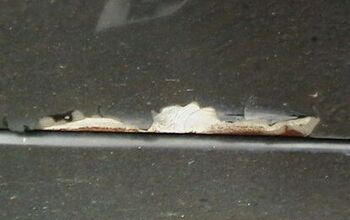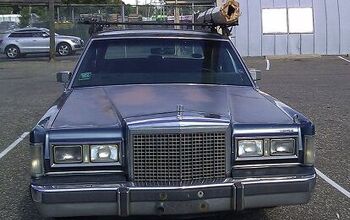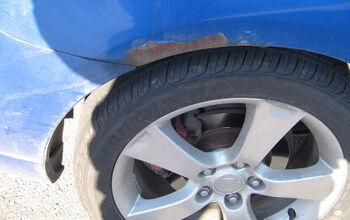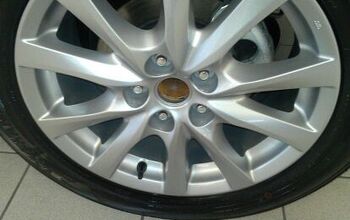Piston Slap: American Rust Vs. Japanese Rust?

Stefan writes:
Sajeev, I recently had a conversation with my cousin in Wisconsin. He claimed that cars assembled in North America are more rust prone than cars assembled in Japan or other oriental countries. Apparently his observation was based on several cars in our extended family: An elderly Dodge Durango and a not-so-elderly Honda Odyssey with the traditional clapped-out transmission.
I have never seen any statistics to support these ideas and really don’t recall reading suchlike statements in the TTAC in the past. That older American cars rust more than newer Japanese, and vice versa, seems natural and I recall seeing many old Japanese cars with severe corrosion damage, but what is the truth in this matter? Over to you and the B & B!
Stefan (’97 Fat Panther without a speck of rust)
Sajeev answers:
This is pure Internet Troll Bait, but whatever…I’ll bite.
Cars made in Japan used to be inadequate for use in the American Rust Belt, back in the 1970s. That’s history, as Japan wised up and eventually made the vehicles that would dominate the marketplace in every American market they compete in. (well, except trucks )
The only modern cars that I’ve seen (and I live in Houston) or heard to be chronically rusty are Mazdas from the last decade. Discussed here, here and here. Oh, and the Toyota Tacoma, witnessed by the massive recall. One person mentioned a Ford Focus, and that’s about it.
And in this most unscientific sampling, only the Mazda is not made in North America. So your cousin is wrong.
Dead Wrong: USA, USA, USA!!!
Off to you, Best and Brightest.
[Image: Shutterstock user Sirinn3249]
Send your queries to sajeev@thetruthaboutcars.com. Spare no details and ask for a speedy resolution if you’re in a hurry…but be realistic, and use your make/model specific forums instead of TTAC for more timely advice.

More by Sajeev Mehta
Latest Car Reviews
Read moreLatest Product Reviews
Read moreRecent Comments
- UnoGeeks Great information. Unogeeks is the top SAP ABAP Training Institute, which provides the best SAP ABAP Training
- ToolGuy This thing here is interesting.For example, I can select "Historical" and "EV stock" and "Cars" and "USA" and see how many BEVs and PHEVs were on U.S. roads from 2010 to 2023."EV stock share" is also interesting. Or perhaps you prefer "EV sales share".If you are in the U.S., whatever you do, do not select "World" in the 'Region' dropdown. It might blow your small insular mind. 😉
- ToolGuy This podcast was pretty interesting. I listened to it this morning, and now I am commenting. Listened to the podcast, now commenting on the podcast. See how this works? LOL.
- VoGhost If you want this to succeed, enlarge the battery and make the vehicle in Spartanburg so you buyers get the $7,500 discount.
- Jeff Look at the the 65 and 66 Pontiacs some of the most beautiful and well made Pontiacs. 66 Olds Toronado and 67 Cadillac Eldorado were beautiful as well. Mercury had some really nice looking cars during the 60s as well. The 69 thru 72 Grand Prix were nice along with the first generation of Monte Carlo 70 thru 72. Midsize GM cars were nice as well.The 69s were still good but the cheapening started in 68. Even the 70s GMs were good but fit and finish took a dive especially the interiors with more plastics and more shared interiors.


































Comments
Join the conversation
Around Toledo, it used to be Toyota trucks, and the Vegas/Monzas/pick your clones that used to be the really fast rusters, with the Toyota trucks being way worse than anything else I can think of. A neighbor bought a new Toyota truck, I think it was an '85, and I've never seen anything that hadn't been burned rust like it did. It was kind of a lighter blue, and the rust first showed up as darker spots along that insanely badly done seam those trucks had. After only a couple years, the bed had holes bigger than my fist, and the cab was going too, but more slowly. The bed was replaced with this weird railroad tie and green treated lumber flatbed thing that outlasted the cab. When the top of the windshield rotted out, it was gone, replaced by one of the boxy F150's from the early 1990's. The F150 lasted a long time, and was only replaced a couple of years ago by a stripped Chevy Silverado W/T. The F150 hadn't died of rust, it died due to a spun bearing and slipping transmission. It had rust in the usual spots, but wasn't even close to being scrapped due to rust. My former, and later on, a friend's 1988 S-10 Blazer died in 2012, after almost 500K miles on the original short block due to the windshield/roof area rotting out. I see quite a few of them still running around, so I think a messed up windshield replacement after it was stolen the first of two times might have had some part in it's rusting so badly in that area. He bought one of the first GMC Envoys and it's still going strong on it's second engine. The original was running fine when his wife ignored the oil light coming on and kept driving it. A bad oil leak caused by a rock or something that hit the pan and cracked it, causing it to leak. She ignored the huge spot on the driveway and in her parking spot at work, until the lack of oil caused the engine to seize. Needless to say, she received some intense, uh, education, about not driving it with the oil light on.
....and Japan doesn't use salt on their roads and highways, even in northern Japan.